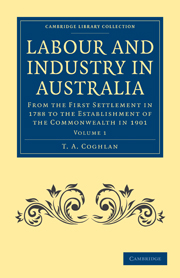 Labour and Industry in Australia
Labour and Industry in Australia Book contents
- Frontmatter
- PREFACE
- Contents
- PART I FROM THE FOUNDATION OF SETTLEMENT TO THE CROSSING OF THE MOUNTAINS
- I INTRODUCTION TO THE FIRST PERIOD
- II THE ASSIGNMENT SYSTEM
- III MUSTERS
- IV WAGES AND WORKING HOURS
- V THE CURRENCY
- VI LAND POLICY
- VII THE GENESIS OF THE WOOL INDUSTRY IN AUSTRALIA
- VIII THE INDUSTRIES OF THE PERIOD
- IX TRADE AND PRICES
- PART II FROM THE CROSSING OF THE MOUNTAINS TO THE ABOLITION OF THE ASSIGNMENT SYSTEM
- PART III FROM THE ABOLITION OF THE ASSIGNMENT SYSTEM TO THE DISCOVERY OF GOLD
- PART IV FROM THE DISCOVERY OF GOLD TO THE INTRODUCTION OF FREE SELECTION OF LAND BEFORE SURVEY
- Frontmatter
- PREFACE
- Contents
- PART I FROM THE FOUNDATION OF SETTLEMENT TO THE CROSSING OF THE MOUNTAINS
- I INTRODUCTION TO THE FIRST PERIOD
- II THE ASSIGNMENT SYSTEM
- III MUSTERS
- IV WAGES AND WORKING HOURS
- V THE CURRENCY
- VI LAND POLICY
- VII THE GENESIS OF THE WOOL INDUSTRY IN AUSTRALIA
- VIII THE INDUSTRIES OF THE PERIOD
- IX TRADE AND PRICES
- PART II FROM THE CROSSING OF THE MOUNTAINS TO THE ABOLITION OF THE ASSIGNMENT SYSTEM
- PART III FROM THE ABOLITION OF THE ASSIGNMENT SYSTEM TO THE DISCOVERY OF GOLD
- PART IV FROM THE DISCOVERY OF GOLD TO THE INTRODUCTION OF FREE SELECTION OF LAND BEFORE SURVEY
Summary
Before Governor Phillip allowed his prisoners on the First Fleet to land, he assembled them on the decks of the transports and made inquiry concerning various matters of which he wished to be informed. This muster, which would probably have been held in any case, was rendered necessary by the circumstance that the papers relating to the prisoners had been left behind in England, but the experience of the First Fleet was the experience of the second and of every other that came to Australia. This formal muster on shipboard was the visible sign of the transfer of the convicts to their new masters, and was conducted by the Governor's secretary and the superintendent of convicts on the quarter-deck of each vessel, in the presence of the surgeon-superintendent, the captain, and the ship's company. Each convict was asked his name, the time and place of his trial, his sentence, birthplace, age, trade or occupation, and his replies were compared with the particulars set out in the documents received from England. Further, to establish his identity, his features were noted, his bodily marks and characteristics carefully set down, and the state of his health ascertained. When all had been examined, the prisoners were invited to state any complaints they desired to make as to their treatment on the passage, and when these were recorded, the clothing they were to wear in their new home was given to them.
- Type
- Chapter
- Information
- Labour and Industry in AustraliaFrom the First Settlement in 1788 to the Establishment of the Commonwealth in 1901, pp. 40 - 47Publisher: Cambridge University PressPrint publication year: 2011First published in: 1918


